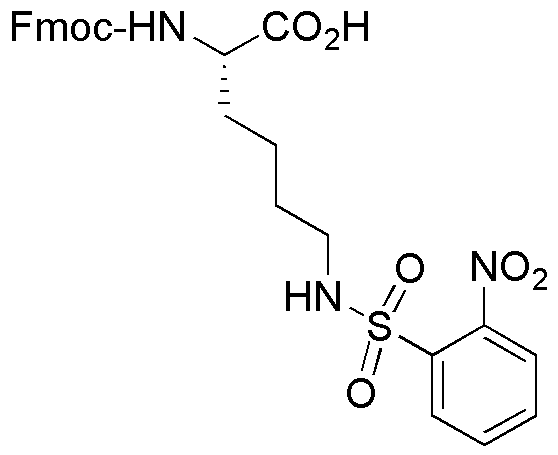Na-Fmoc-Ne-Nosyl-L-lysine is widely utilized in research focused on:
- Peptide Synthesis: This compound serves as a protecting group in the synthesis of peptides, allowing for selective reactions and the formation of complex structures. Its stability under various conditions makes it a preferred choice for researchers in organic chemistry.
- Drug Development: In pharmaceutical research, it is used to create novel drug candidates by modifying peptide sequences, which can lead to improved efficacy and reduced side effects in therapeutic applications.
- Bioconjugation: The compound facilitates the attachment of biomolecules to surfaces or other molecules, enhancing the development of targeted drug delivery systems and diagnostic tools in biotechnology.
- Protein Engineering: Researchers utilize it in the design of modified proteins, which can exhibit enhanced stability and activity, crucial for applications in enzyme technology and therapeutic proteins.
- Research in Cancer Therapeutics: Its role in synthesizing peptide-based inhibitors allows for the exploration of new cancer treatments, providing a pathway for developing more effective therapies with fewer side effects.
General Information
Properties
Safety and Regulations
Applications
Na-Fmoc-Ne-Nosyl-L-lysine is widely utilized in research focused on:
- Peptide Synthesis: This compound serves as a protecting group in the synthesis of peptides, allowing for selective reactions and the formation of complex structures. Its stability under various conditions makes it a preferred choice for researchers in organic chemistry.
- Drug Development: In pharmaceutical research, it is used to create novel drug candidates by modifying peptide sequences, which can lead to improved efficacy and reduced side effects in therapeutic applications.
- Bioconjugation: The compound facilitates the attachment of biomolecules to surfaces or other molecules, enhancing the development of targeted drug delivery systems and diagnostic tools in biotechnology.
- Protein Engineering: Researchers utilize it in the design of modified proteins, which can exhibit enhanced stability and activity, crucial for applications in enzyme technology and therapeutic proteins.
- Research in Cancer Therapeutics: Its role in synthesizing peptide-based inhibitors allows for the exploration of new cancer treatments, providing a pathway for developing more effective therapies with fewer side effects.
Documents
Safety Data Sheets (SDS)
The SDS provides comprehensive safety information on handling, storage, and disposal of the product.
Product Specification (PS)
The PS provides a comprehensive breakdown of the product’s properties, including chemical composition, physical state, purity, and storage requirements. It also details acceptable quality ranges and the product's intended applications.
Certificates of Analysis (COA)
Search for Certificates of Analysis (COA) by entering the products Lot Number. Lot and Batch Numbers can be found on a product’s label following the words ‘Lot’ or ‘Batch’.
*Catalog Number
*Lot Number
Certificates Of Origin (COO)
This COO confirms the country where the product was manufactured, and also details the materials and components used in it and whether it is derived from natural, synthetic, or other specific sources. This certificate may be required for customs, trade, and regulatory compliance.
*Catalog Number
*Lot Number
Safety Data Sheets (SDS)
The SDS provides comprehensive safety information on handling, storage, and disposal of the product.
DownloadProduct Specification (PS)
The PS provides a comprehensive breakdown of the product’s properties, including chemical composition, physical state, purity, and storage requirements. It also details acceptable quality ranges and the product's intended applications.
DownloadCertificates of Analysis (COA)
Search for Certificates of Analysis (COA) by entering the products Lot Number. Lot and Batch Numbers can be found on a product’s label following the words ‘Lot’ or ‘Batch’.
*Catalog Number
*Lot Number
Certificates Of Origin (COO)
This COO confirms the country where the product was manufactured, and also details the materials and components used in it and whether it is derived from natural, synthetic, or other specific sources. This certificate may be required for customs, trade, and regulatory compliance.


